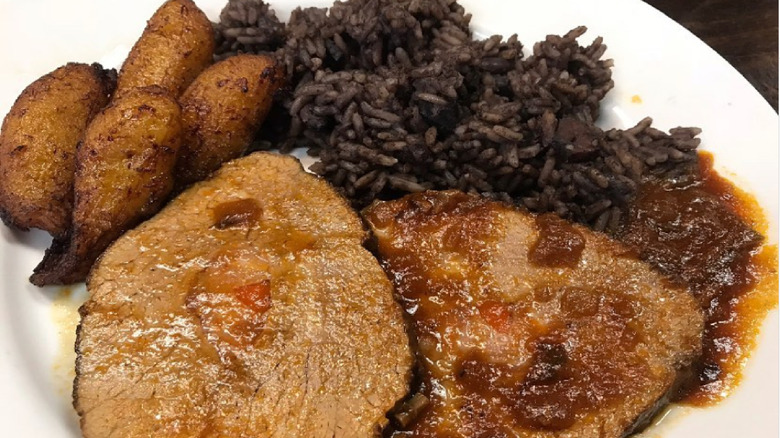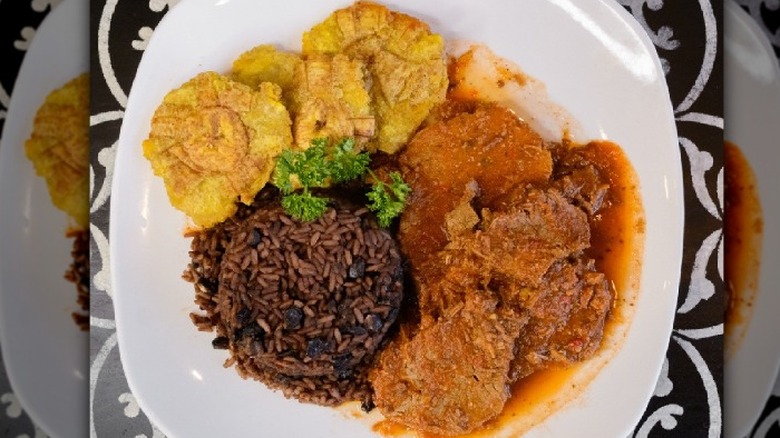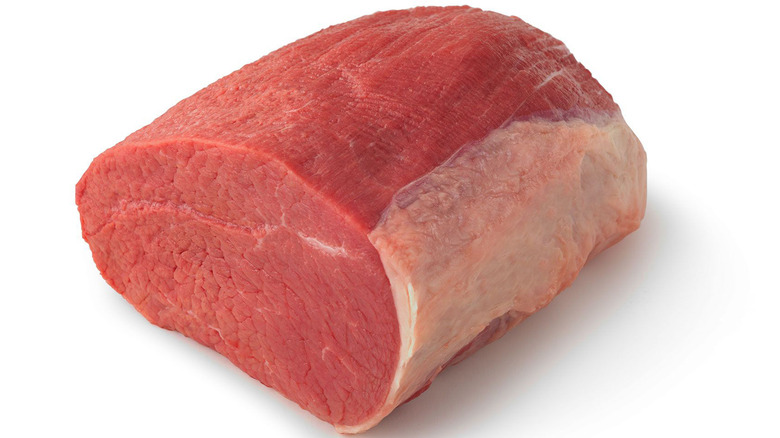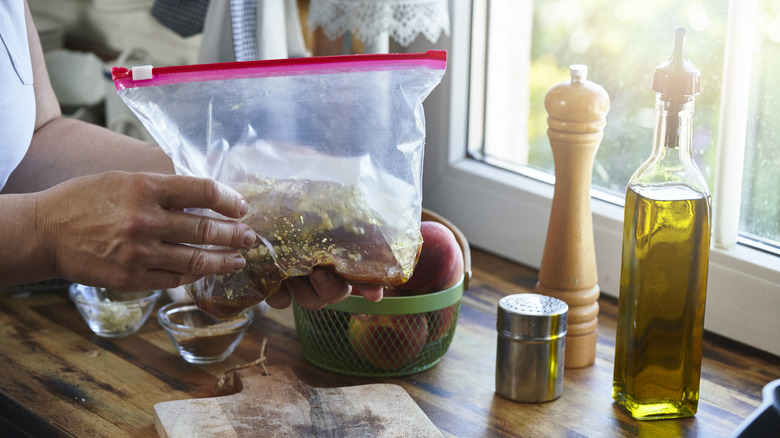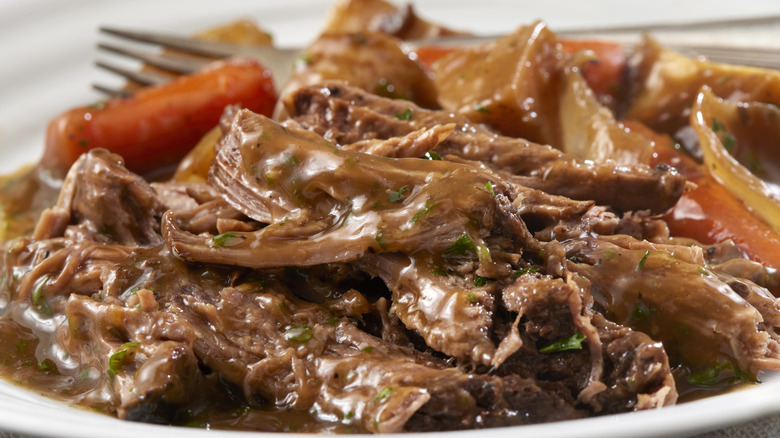Boliche Is The Classic Cuban Pot Roast You Should Know About
Pot roasts are a special brand of comfort food, with their tender meaty textures and buttery veg — a single bite can transport one right back to hearth and home. However, when slow-cooking beef in broth, it can feel difficult to invigorate the dish with a new flavor palette, but it's been done. For a different take on a pot roast, turn to Cuban boliche.
The dish comprises an eye of round stuffed with cured pork, potatoes, and other vegetables, all of which are slathered in a marinade infused with beef juices and flavorful liquified onion. It's still essentially the same beloved pot roast ingredients, but there's something else in the preparation that sets this Cuban classic apart. Before cooked, the beef is marinaded for up to two days in a complex blend of citrus, spices, and often wine. Once the beef cut has soaked up the various flavors, it's cut into thick slices, offering a zesty Caribbean kick compared to the traditional savory sort.
History of boliche
As a result of its complex history, Cuban gastronomy fuses a variety of influences, the most predominant being Spain, due to its nearly 400-year rule over the island. Over this period, the Spanish empire introduced animal livestock like cows and pigs, which is how we get the unique pork-stuffed beef cut. Further, most people that came to the island during the early period of colonization hailed from the Andalusia province, a southern region of Spain where stews continue to be popular. In such Spanish recipes, varying proteins like beef and chorizo are often mixed together — like in the dish Puchero. The ham cuts used in boliche, be it jamon serrano or chorizo, also arose from Spanish origins.
In addition to Spanish, Indigenous Taino, Caribbean, African, and other Latin American foods also influence Cuban cuisine. While it's difficult to pinpoint the cuisine's exact synthesis into boliche, the dish shares similarities with other foods in this region. For instance, its sour orange marinade is reminiscent of Yucatán's Cochinita Pibil, while its inclusion of potatoes alludes to West African dishes. No matter the similarities, boliche now exists as a wholly unique Cuban creation.
What's in boliche?
As with any roast, the dish begins with a careful selection of meat. Boliche reaches for eye of round, a lean but flavorful cut beloved for slow-cooking. Lengthy marination, a braising liquid, as well as fat from the pork, will keep this cut moist, so don't stress about it being tough. Serrano, bacon, and chorizo are all popular candidates for the roasts inner ham stuffing. Chorizo especially provides great flavor, its piquant character and fats helping season and soften this cut from the inside out.
The marinade paste is constituted of a base of garlic, oregano, salt, and pepper with the added zing of citrus juices like orange, lime, and lemon, as well as a sprinkling of paprika and bay leaves for depth. To complement the hearty citrus flavor, salty olives, are an optional addition to the filling. Some also add white wine for an extra tinge of something sweet and complex. And, of course, there's an assortment of savory root vegetables — such as onions, potatoes, carrots — to round out the roast.
How to make and serve boliche
To stuff the roast, create a hole through the middle of the beef by either using a skewer or a long boning knife. Incise on the flat side of the meat to retain its form. After stuffing, place the onions and the beef into a large vessel for marinating. Cover with plastic wrap, and set aside in the fridge anywhere from 3 to 48 hours — the longer, the better.
Though referred to as a roast, boliche is technically braised, as it comes together on the stovetop in a large volume of liquid. First, brown the meat on the sides to seal in the juices, then soften the onions, and finally pour in the marinade and beef broth. After heating to a boil, simmer for around 4 hours with a cover, checking the level of the liquid every now and then. A half-hour prior to the end of the cook time, add in the root vegetables.
Serve it up by dividing up the vegetables on the bottom of the plates. Slice the eye of round into thick pieces — around half an inch — and place on top. Black beans and rice, a Cuban staple side, is common here, and makes this roast rendition all the more hearty.
How Boliche varies from other roasts
As a staple of home-cooked dinners, there are lots of boliche variations among cooks. Most deviations occur in the ham filling, substituting serrano, bacon, chorizo, or another cured meat on hand. The same applies to the vegetables incorporated into the roast — some make boliche a hearty potato dish, or instead keep it sauce-heavy to serve with sides. And the seasoning choice also varies between chefs.
Despite such variations, boliche's skillet-braising technique applied to an eye of round cut is a cornerstone of the dish. Unlike an oven-style roast, which uses low and slow heat to retain moisture, boliche's preparation in liquid infuses it with an abundance of flavor. Such a quality makes it similar to an American-style pot roast, which also incorporates vegetables and relies on a broth to tenderize the beef. While the cooking time of the two dishes is similar, boliche's beef exhibits a different texture. The acid present in the marinade lends the meat a soft consistency that doesn't shred apart. Plus, the cut is infused with more flavor due to the aromatic components. All the more reason to prep boliche for a fabulous dinner — not going for seconds will be impossible.
